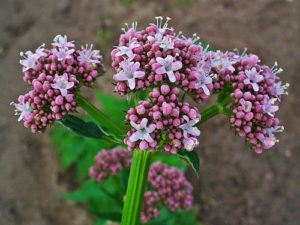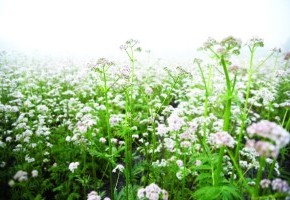
 (http://www.motherearthliving.com/natural-health/valeriana-officinalis-grow-valerian-natural-sleep-aid.aspx#axzz36F1n5Nsp)
(http://www.motherearthliving.com/natural-health/valeriana-officinalis-grow-valerian-natural-sleep-aid.aspx#axzz36F1n5Nsp)
GROWING NOTES
Valerian grows to a height of 3-4' and begins blooming early in the season, sometimes in late spring. The pink and white flowers grow in clusters and are favorite of many types of insects.
Valerian favors full sun and a humus rich soil, and lots of water.
MAINTAINING
Can be direct sown outdoors in early spring, or started indoors 4 weeks prior to transplanting in late spring. Small seeds can be tamped into the soil or covered with a thin layer of soil, approximately 1/4", and should germinate within 7-14 days with moist but well-drained potting mix.
HARVESTING
Root can be collected in the fall. Valerian can sometimes be collected in the first year, but will often require at least an additional year to reach sizable quantities worthy of collection.
(http://www.heirloom-organics.com/guide/va/guidetogrowingvalerian.html)

MATERIA MEDICA: VALERIAN
Latin Name: Valeriana spp., including V. officinalis Family: Valerianaceae Parts Used: Root, rhizome Actions: Anodyne, anthelmintic, antibacterial, antispasmodic, aromatic, astringent, bitter, carminative, diaphoretic, diuretic, febrifuge, hypnotic, hypotensive, nervous system tonic, nervine, restorative, sedative, smooth muscle relaxant, stomachic, tonic.- Tea - steep 1-2 teaspoons in 12 oz hot water for 10-15 minutes. Drink 1-2 hours before bed time to help calm the system
- Tincture - 60-90 drops in a small amount of water, 1-2 times in the hour leading up to bed.
- Do not use large doses for more than three weeks in a row. Small nightly doses are typically fine.
- Do not give to children under the age of three.
- Avoid during pregnancy, except in small doses.
- Use with caution if driving heavy machinery or doing any other activities that may require a quick reaction time after taking valerian.
- Avoid long term use of valerian in cases of depression.
- Large doses of valerian can cause depression, nausea, headache, and lethargy.
- Some people experience the opposite effect with valerian, in otherwords it keeps them up at night. This happens with about 25% of the population, so it's best to try valerian for the first time on a night when you don't have much to do the next day in case you are someone this happens to...otherwise you'll have a great night's sleep!



